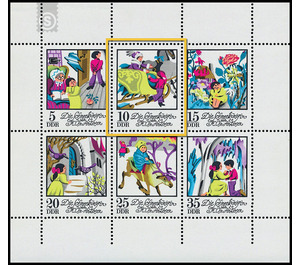Commemorative stamp series - Germany / German Democratic Republic 1972 - 10 Pfennig
Theme: Animals
| Country | Germany / German Democratic Republic |
| Issue Date | 1972 |
| Face Value | 10.00 |
| Color | multi-colored |
| Perforation | K 13:13 1/2 |
| Printing Type | offset |
| Stamp Type | Postage stamp |
| Item Type | Stamp |
| Chronological Issue Number | 1544 |
| Chronological Chapter | GER-DDR |
| SID | 900637 |
| In 15 Wishlists | |
Winter's Tale - The Snow Queen The Ministry of Posts and Telecommunications of the German Democratic Republic publishes six multi-colored special postage stamps depicting the winter fairy tale "Die Schneekönigin" by the Danish poet Hans Christian Andersen. The six stamps are printed on a miniature sheet. No special first-day cover The Snow Queen The Danish poet Hans Christian Andersen (born April 2, 1804 in Odensee, died August 4, 1875 in Copenhagen) created this fairy tale in 1844. It appeared in 1845 in a small volume "Nye Eventyr af H. C. Andersen, Andes Samlin: Granstraet - Sneedronnignen". Andersen had already published in 1835 a first collection "fairy tales, tells for children". Small collections followed year after year, followed shortly thereafter by German editions. Until his death, Andersen published over 150 fairytales. Andersen was inspired to his fairy tales of motifs and forms of folk tales and the German romantic art fairy tale. His first fairy tales are still retellings or re-seals of old folktales. But even in the fairy tales of his own invention, one senses the influence of folk poetry. With his fairy tales Andersen created a new kind of fairytale seal. His poetry differs from the old folktale by its modern content of thought and deliberately influenced style, from the romantic fairy tale through its vividness, closeness to reality and popular naivety. For his great fairytale cycle "The Snow Queen", Andersen gave him the subtitle "A fairy tale in seven stories", he borrowed motifs from all over and created a completely independent poetry. On January 20, 1845, Andersen wrote to the hereditary Grand Duke Carl Alexander of Saxe-Weimar-Eisenach about this fairy tale: "My two newest fairy tales are: the Christmas tree and the Snow Queen, the last is considered one of my best and carries the idea through, like that Mind over cold reason triumphs. " The most important episodes of the fairy tale are arranged in the stamp series as follows: The devil had made a mirror that made everything good and beautiful disappear into nothing and emphasized everything bad. As the mirror shattered, each splinter had the property of the mirror. The little Kay, who had always played with the neighboring child, the little Gerda, gets a splinter in the eye and in the heart. He's been dissatisfied with everything since then and keeps teasing little Gerda. (5-cent value). Kay had tied his sled to a big white sled while playing to get some exercise. The ride is getting faster and faster and he can not get away from it. Finally, he is asked to come in the big sled. (10-cent value). There sits the Snow Queen, who takes him in her fur and kisses him, so that he forgets Gerda and all. In search of Kay, little Gerda comes to an old woman who wants to keep Gerda with her and takes her memory of Kay. Through a rose her Kay falls again. Now she asks all flowers for him, but each tells her only her own story. (15-cent value). Gerda keeps running. A crow tells her that Kay may be the guy the princess married because he could answer so well. The crow leads Gerda into the castle with the help of her sweetheart. (20-cent value). But the prince is not Kay. As a prisoner of a band of robbers, Gerda learns from the pigeons that Kay is with the Snow Queen. A robber girl gives Gerda a reindeer that knows the way to the Snow Queen and lets her flee. With the help of a Laplander and a Finnlander (25-pfennig value) Gerda comes to the garden of the Snow Queen. Despite all the obstacles, Gerda manages to penetrate the castle of the Snow Queen and find Kay. He sits frozen and cold in front of a frozen lake and plays the "mind game", if he puts the pieces of ice together so that a certain word would come out, he should be free. As Gerda falls crying Kay's neck, her tears penetrate his heart, loosen the lump of ice and consume the splinter of the mirror. Then Kay burst into tears and the tears roll the mirror pieces out of his eye. (35-cent value). The pieces of ice dance for joy and take themselves to the desired word "eternity". Kay was now free and both return home.


